Conquering Mechanical Engineering Problems in Cyber-Physical Systems (CPS)
VerifiedAdded on 2023/06/03
|10
|2463
|139
AI Summary
This paper evaluates how mechanical engineers can leverage their ability in conquering engineering problem when developing cyber-physical systems for improved physical production. Annotated bibliography provides a list of key sources to be used in this paper that primary target mechanical engineers.
Contribute Materials
Your contribution can guide someone’s learning journey. Share your
documents today.
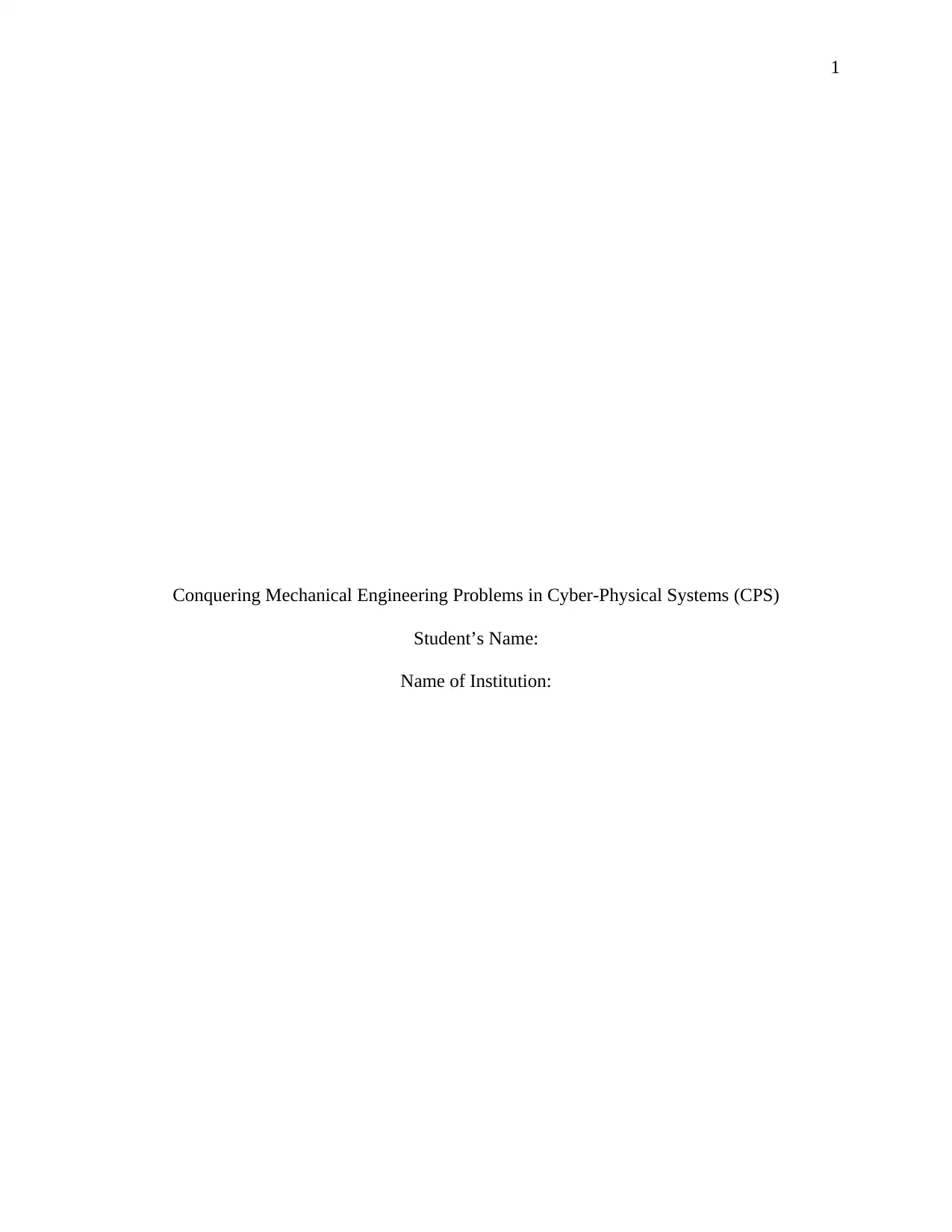
1
Conquering Mechanical Engineering Problems in Cyber-Physical Systems (CPS)
Student’s Name:
Name of Institution:
Conquering Mechanical Engineering Problems in Cyber-Physical Systems (CPS)
Student’s Name:
Name of Institution:
Secure Best Marks with AI Grader
Need help grading? Try our AI Grader for instant feedback on your assignments.
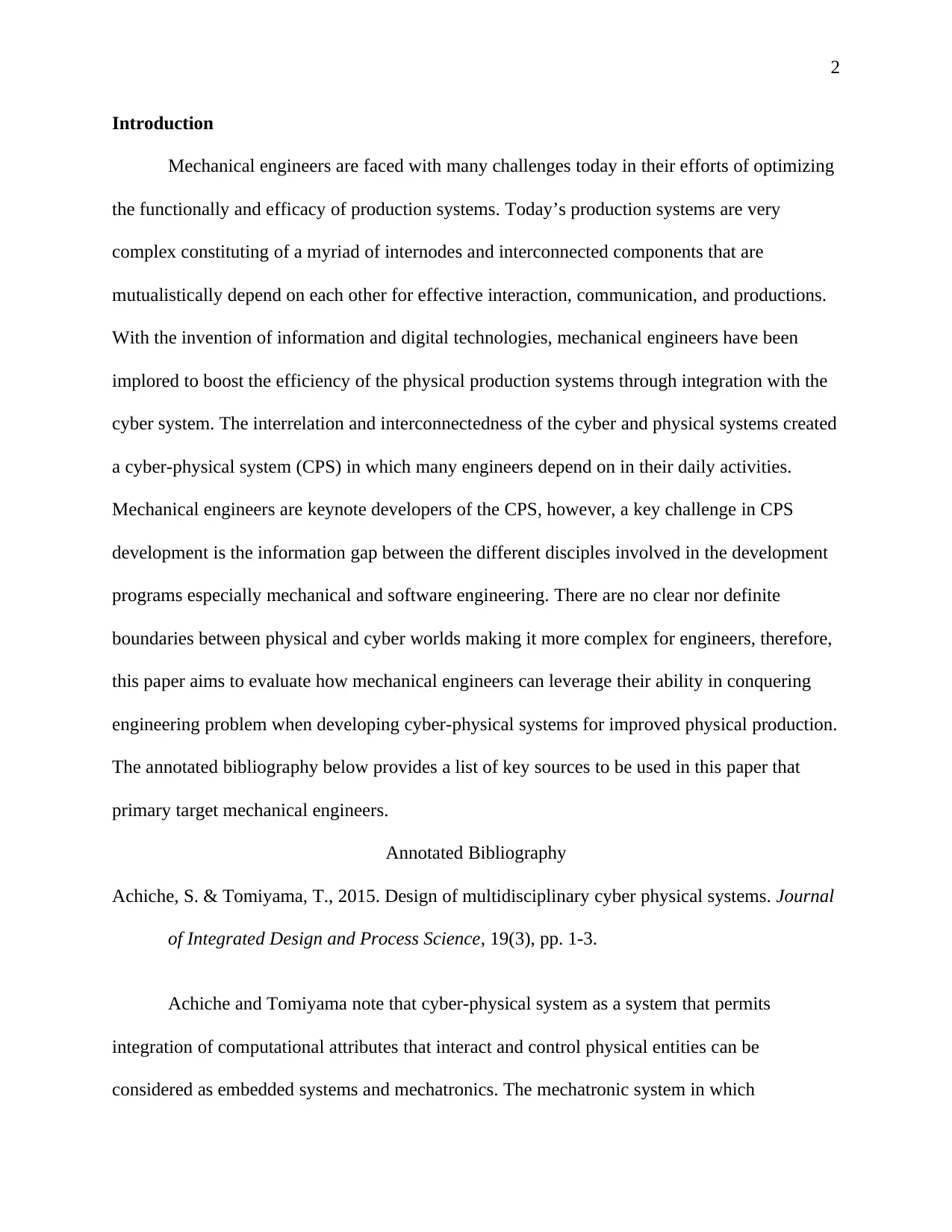
2
Introduction
Mechanical engineers are faced with many challenges today in their efforts of optimizing
the functionally and efficacy of production systems. Today’s production systems are very
complex constituting of a myriad of internodes and interconnected components that are
mutualistically depend on each other for effective interaction, communication, and productions.
With the invention of information and digital technologies, mechanical engineers have been
implored to boost the efficiency of the physical production systems through integration with the
cyber system. The interrelation and interconnectedness of the cyber and physical systems created
a cyber-physical system (CPS) in which many engineers depend on in their daily activities.
Mechanical engineers are keynote developers of the CPS, however, a key challenge in CPS
development is the information gap between the different disciples involved in the development
programs especially mechanical and software engineering. There are no clear nor definite
boundaries between physical and cyber worlds making it more complex for engineers, therefore,
this paper aims to evaluate how mechanical engineers can leverage their ability in conquering
engineering problem when developing cyber-physical systems for improved physical production.
The annotated bibliography below provides a list of key sources to be used in this paper that
primary target mechanical engineers.
Annotated Bibliography
Achiche, S. & Tomiyama, T., 2015. Design of multidisciplinary cyber physical systems. Journal
of Integrated Design and Process Science, 19(3), pp. 1-3.
Achiche and Tomiyama note that cyber-physical system as a system that permits
integration of computational attributes that interact and control physical entities can be
considered as embedded systems and mechatronics. The mechatronic system in which
Introduction
Mechanical engineers are faced with many challenges today in their efforts of optimizing
the functionally and efficacy of production systems. Today’s production systems are very
complex constituting of a myriad of internodes and interconnected components that are
mutualistically depend on each other for effective interaction, communication, and productions.
With the invention of information and digital technologies, mechanical engineers have been
implored to boost the efficiency of the physical production systems through integration with the
cyber system. The interrelation and interconnectedness of the cyber and physical systems created
a cyber-physical system (CPS) in which many engineers depend on in their daily activities.
Mechanical engineers are keynote developers of the CPS, however, a key challenge in CPS
development is the information gap between the different disciples involved in the development
programs especially mechanical and software engineering. There are no clear nor definite
boundaries between physical and cyber worlds making it more complex for engineers, therefore,
this paper aims to evaluate how mechanical engineers can leverage their ability in conquering
engineering problem when developing cyber-physical systems for improved physical production.
The annotated bibliography below provides a list of key sources to be used in this paper that
primary target mechanical engineers.
Annotated Bibliography
Achiche, S. & Tomiyama, T., 2015. Design of multidisciplinary cyber physical systems. Journal
of Integrated Design and Process Science, 19(3), pp. 1-3.
Achiche and Tomiyama note that cyber-physical system as a system that permits
integration of computational attributes that interact and control physical entities can be
considered as embedded systems and mechatronics. The mechatronic system in which
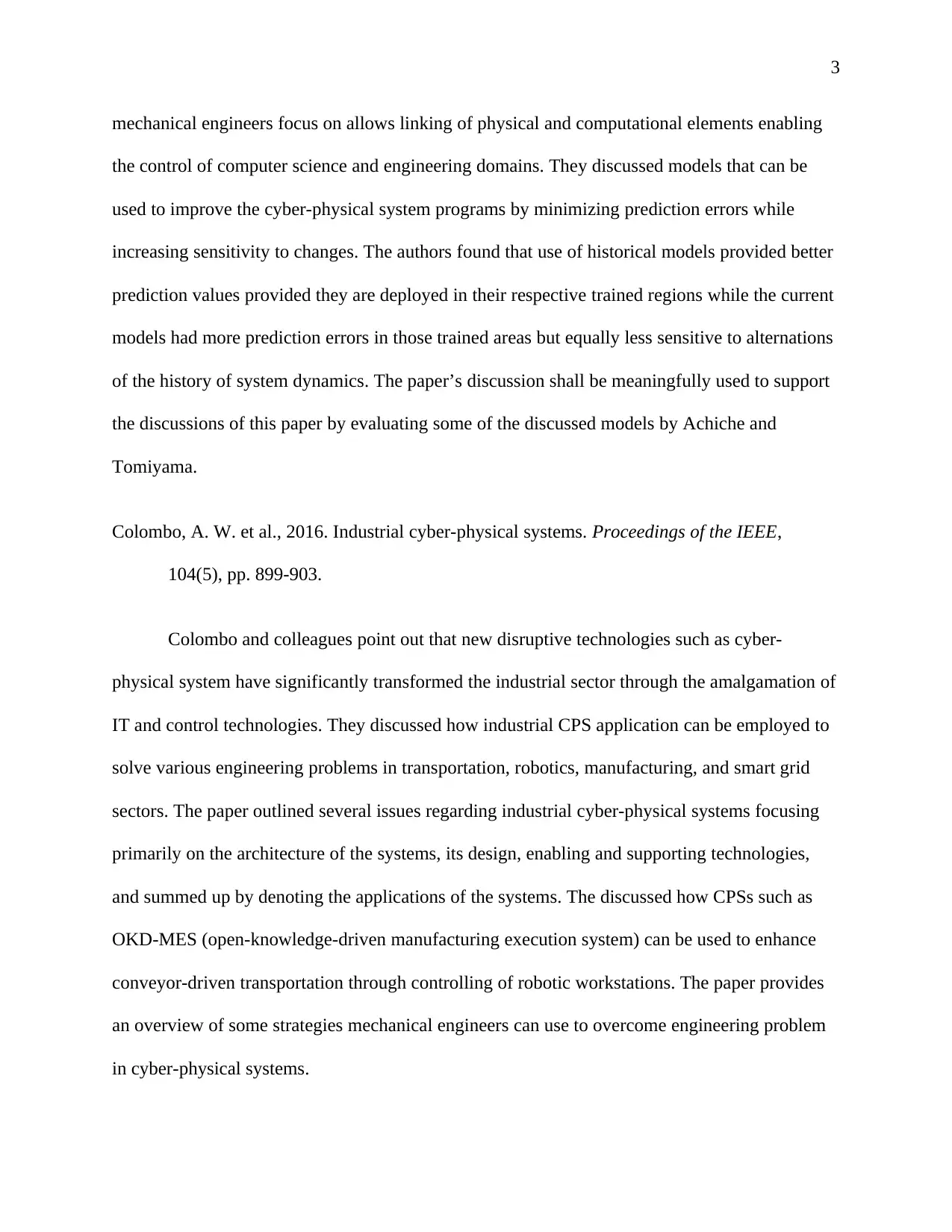
3
mechanical engineers focus on allows linking of physical and computational elements enabling
the control of computer science and engineering domains. They discussed models that can be
used to improve the cyber-physical system programs by minimizing prediction errors while
increasing sensitivity to changes. The authors found that use of historical models provided better
prediction values provided they are deployed in their respective trained regions while the current
models had more prediction errors in those trained areas but equally less sensitive to alternations
of the history of system dynamics. The paper’s discussion shall be meaningfully used to support
the discussions of this paper by evaluating some of the discussed models by Achiche and
Tomiyama.
Colombo, A. W. et al., 2016. Industrial cyber-physical systems. Proceedings of the IEEE,
104(5), pp. 899-903.
Colombo and colleagues point out that new disruptive technologies such as cyber-
physical system have significantly transformed the industrial sector through the amalgamation of
IT and control technologies. They discussed how industrial CPS application can be employed to
solve various engineering problems in transportation, robotics, manufacturing, and smart grid
sectors. The paper outlined several issues regarding industrial cyber-physical systems focusing
primarily on the architecture of the systems, its design, enabling and supporting technologies,
and summed up by denoting the applications of the systems. The discussed how CPSs such as
OKD-MES (open-knowledge-driven manufacturing execution system) can be used to enhance
conveyor-driven transportation through controlling of robotic workstations. The paper provides
an overview of some strategies mechanical engineers can use to overcome engineering problem
in cyber-physical systems.
mechanical engineers focus on allows linking of physical and computational elements enabling
the control of computer science and engineering domains. They discussed models that can be
used to improve the cyber-physical system programs by minimizing prediction errors while
increasing sensitivity to changes. The authors found that use of historical models provided better
prediction values provided they are deployed in their respective trained regions while the current
models had more prediction errors in those trained areas but equally less sensitive to alternations
of the history of system dynamics. The paper’s discussion shall be meaningfully used to support
the discussions of this paper by evaluating some of the discussed models by Achiche and
Tomiyama.
Colombo, A. W. et al., 2016. Industrial cyber-physical systems. Proceedings of the IEEE,
104(5), pp. 899-903.
Colombo and colleagues point out that new disruptive technologies such as cyber-
physical system have significantly transformed the industrial sector through the amalgamation of
IT and control technologies. They discussed how industrial CPS application can be employed to
solve various engineering problems in transportation, robotics, manufacturing, and smart grid
sectors. The paper outlined several issues regarding industrial cyber-physical systems focusing
primarily on the architecture of the systems, its design, enabling and supporting technologies,
and summed up by denoting the applications of the systems. The discussed how CPSs such as
OKD-MES (open-knowledge-driven manufacturing execution system) can be used to enhance
conveyor-driven transportation through controlling of robotic workstations. The paper provides
an overview of some strategies mechanical engineers can use to overcome engineering problem
in cyber-physical systems.
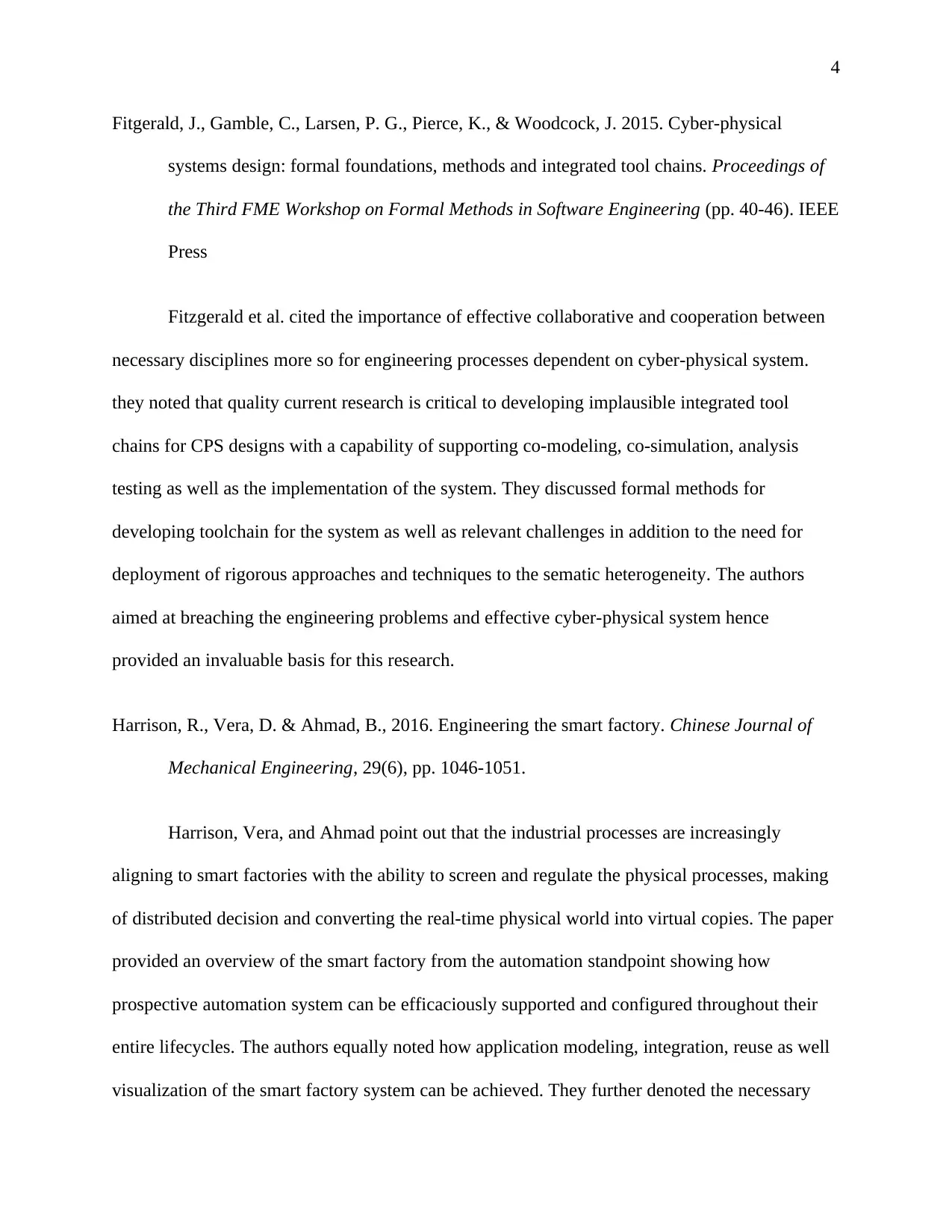
4
Fitgerald, J., Gamble, C., Larsen, P. G., Pierce, K., & Woodcock, J. 2015. Cyber-physical
systems design: formal foundations, methods and integrated tool chains. Proceedings of
the Third FME Workshop on Formal Methods in Software Engineering (pp. 40-46). IEEE
Press
Fitzgerald et al. cited the importance of effective collaborative and cooperation between
necessary disciplines more so for engineering processes dependent on cyber-physical system.
they noted that quality current research is critical to developing implausible integrated tool
chains for CPS designs with a capability of supporting co-modeling, co-simulation, analysis
testing as well as the implementation of the system. They discussed formal methods for
developing toolchain for the system as well as relevant challenges in addition to the need for
deployment of rigorous approaches and techniques to the sematic heterogeneity. The authors
aimed at breaching the engineering problems and effective cyber-physical system hence
provided an invaluable basis for this research.
Harrison, R., Vera, D. & Ahmad, B., 2016. Engineering the smart factory. Chinese Journal of
Mechanical Engineering, 29(6), pp. 1046-1051.
Harrison, Vera, and Ahmad point out that the industrial processes are increasingly
aligning to smart factories with the ability to screen and regulate the physical processes, making
of distributed decision and converting the real-time physical world into virtual copies. The paper
provided an overview of the smart factory from the automation standpoint showing how
prospective automation system can be efficaciously supported and configured throughout their
entire lifecycles. The authors equally noted how application modeling, integration, reuse as well
visualization of the smart factory system can be achieved. They further denoted the necessary
Fitgerald, J., Gamble, C., Larsen, P. G., Pierce, K., & Woodcock, J. 2015. Cyber-physical
systems design: formal foundations, methods and integrated tool chains. Proceedings of
the Third FME Workshop on Formal Methods in Software Engineering (pp. 40-46). IEEE
Press
Fitzgerald et al. cited the importance of effective collaborative and cooperation between
necessary disciplines more so for engineering processes dependent on cyber-physical system.
they noted that quality current research is critical to developing implausible integrated tool
chains for CPS designs with a capability of supporting co-modeling, co-simulation, analysis
testing as well as the implementation of the system. They discussed formal methods for
developing toolchain for the system as well as relevant challenges in addition to the need for
deployment of rigorous approaches and techniques to the sematic heterogeneity. The authors
aimed at breaching the engineering problems and effective cyber-physical system hence
provided an invaluable basis for this research.
Harrison, R., Vera, D. & Ahmad, B., 2016. Engineering the smart factory. Chinese Journal of
Mechanical Engineering, 29(6), pp. 1046-1051.
Harrison, Vera, and Ahmad point out that the industrial processes are increasingly
aligning to smart factories with the ability to screen and regulate the physical processes, making
of distributed decision and converting the real-time physical world into virtual copies. The paper
provided an overview of the smart factory from the automation standpoint showing how
prospective automation system can be efficaciously supported and configured throughout their
entire lifecycles. The authors equally noted how application modeling, integration, reuse as well
visualization of the smart factory system can be achieved. They further denoted the necessary
Secure Best Marks with AI Grader
Need help grading? Try our AI Grader for instant feedback on your assignments.
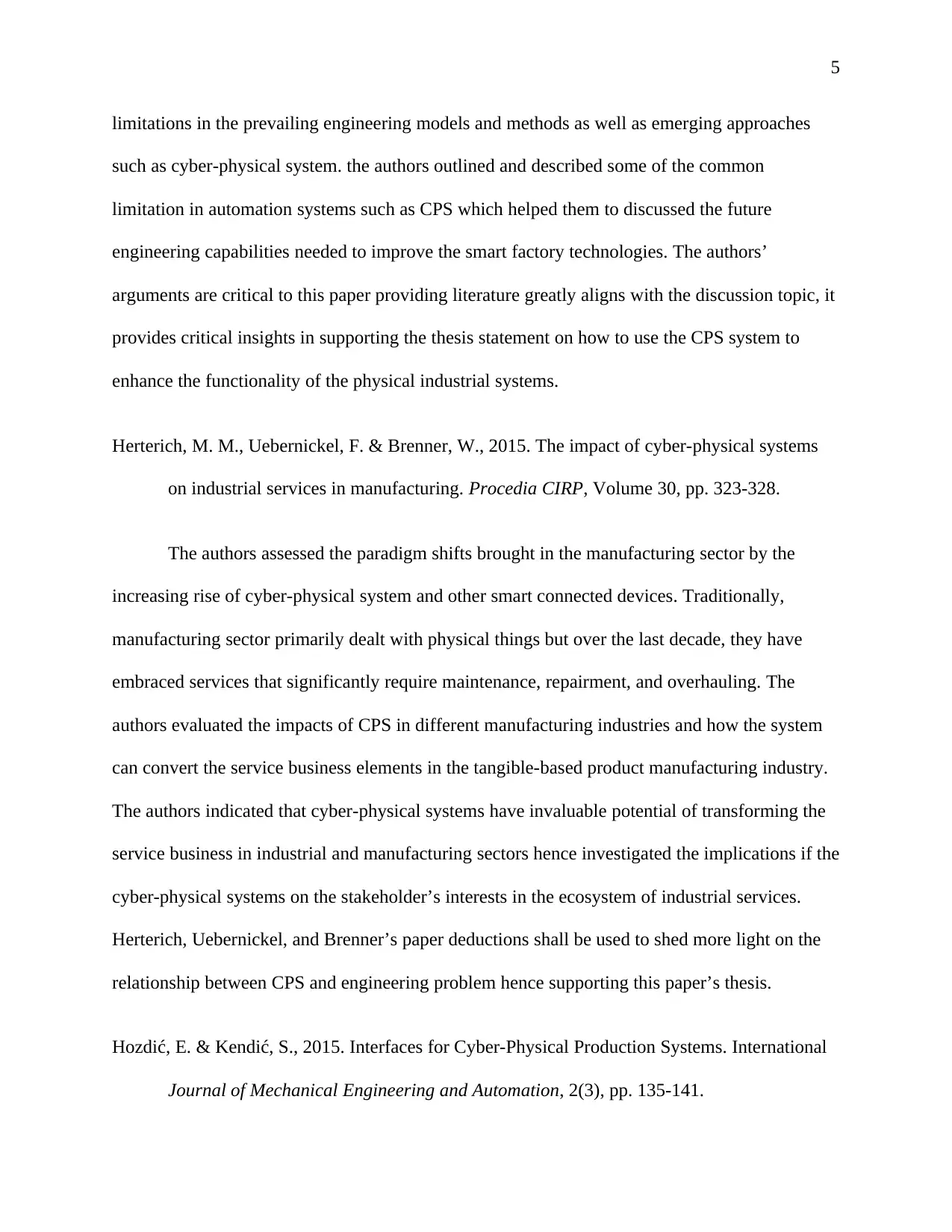
5
limitations in the prevailing engineering models and methods as well as emerging approaches
such as cyber-physical system. the authors outlined and described some of the common
limitation in automation systems such as CPS which helped them to discussed the future
engineering capabilities needed to improve the smart factory technologies. The authors’
arguments are critical to this paper providing literature greatly aligns with the discussion topic, it
provides critical insights in supporting the thesis statement on how to use the CPS system to
enhance the functionality of the physical industrial systems.
Herterich, M. M., Uebernickel, F. & Brenner, W., 2015. The impact of cyber-physical systems
on industrial services in manufacturing. Procedia CIRP, Volume 30, pp. 323-328.
The authors assessed the paradigm shifts brought in the manufacturing sector by the
increasing rise of cyber-physical system and other smart connected devices. Traditionally,
manufacturing sector primarily dealt with physical things but over the last decade, they have
embraced services that significantly require maintenance, repairment, and overhauling. The
authors evaluated the impacts of CPS in different manufacturing industries and how the system
can convert the service business elements in the tangible-based product manufacturing industry.
The authors indicated that cyber-physical systems have invaluable potential of transforming the
service business in industrial and manufacturing sectors hence investigated the implications if the
cyber-physical systems on the stakeholder’s interests in the ecosystem of industrial services.
Herterich, Uebernickel, and Brenner’s paper deductions shall be used to shed more light on the
relationship between CPS and engineering problem hence supporting this paper’s thesis.
Hozdić, E. & Kendić, S., 2015. Interfaces for Cyber-Physical Production Systems. International
Journal of Mechanical Engineering and Automation, 2(3), pp. 135-141.
limitations in the prevailing engineering models and methods as well as emerging approaches
such as cyber-physical system. the authors outlined and described some of the common
limitation in automation systems such as CPS which helped them to discussed the future
engineering capabilities needed to improve the smart factory technologies. The authors’
arguments are critical to this paper providing literature greatly aligns with the discussion topic, it
provides critical insights in supporting the thesis statement on how to use the CPS system to
enhance the functionality of the physical industrial systems.
Herterich, M. M., Uebernickel, F. & Brenner, W., 2015. The impact of cyber-physical systems
on industrial services in manufacturing. Procedia CIRP, Volume 30, pp. 323-328.
The authors assessed the paradigm shifts brought in the manufacturing sector by the
increasing rise of cyber-physical system and other smart connected devices. Traditionally,
manufacturing sector primarily dealt with physical things but over the last decade, they have
embraced services that significantly require maintenance, repairment, and overhauling. The
authors evaluated the impacts of CPS in different manufacturing industries and how the system
can convert the service business elements in the tangible-based product manufacturing industry.
The authors indicated that cyber-physical systems have invaluable potential of transforming the
service business in industrial and manufacturing sectors hence investigated the implications if the
cyber-physical systems on the stakeholder’s interests in the ecosystem of industrial services.
Herterich, Uebernickel, and Brenner’s paper deductions shall be used to shed more light on the
relationship between CPS and engineering problem hence supporting this paper’s thesis.
Hozdić, E. & Kendić, S., 2015. Interfaces for Cyber-Physical Production Systems. International
Journal of Mechanical Engineering and Automation, 2(3), pp. 135-141.
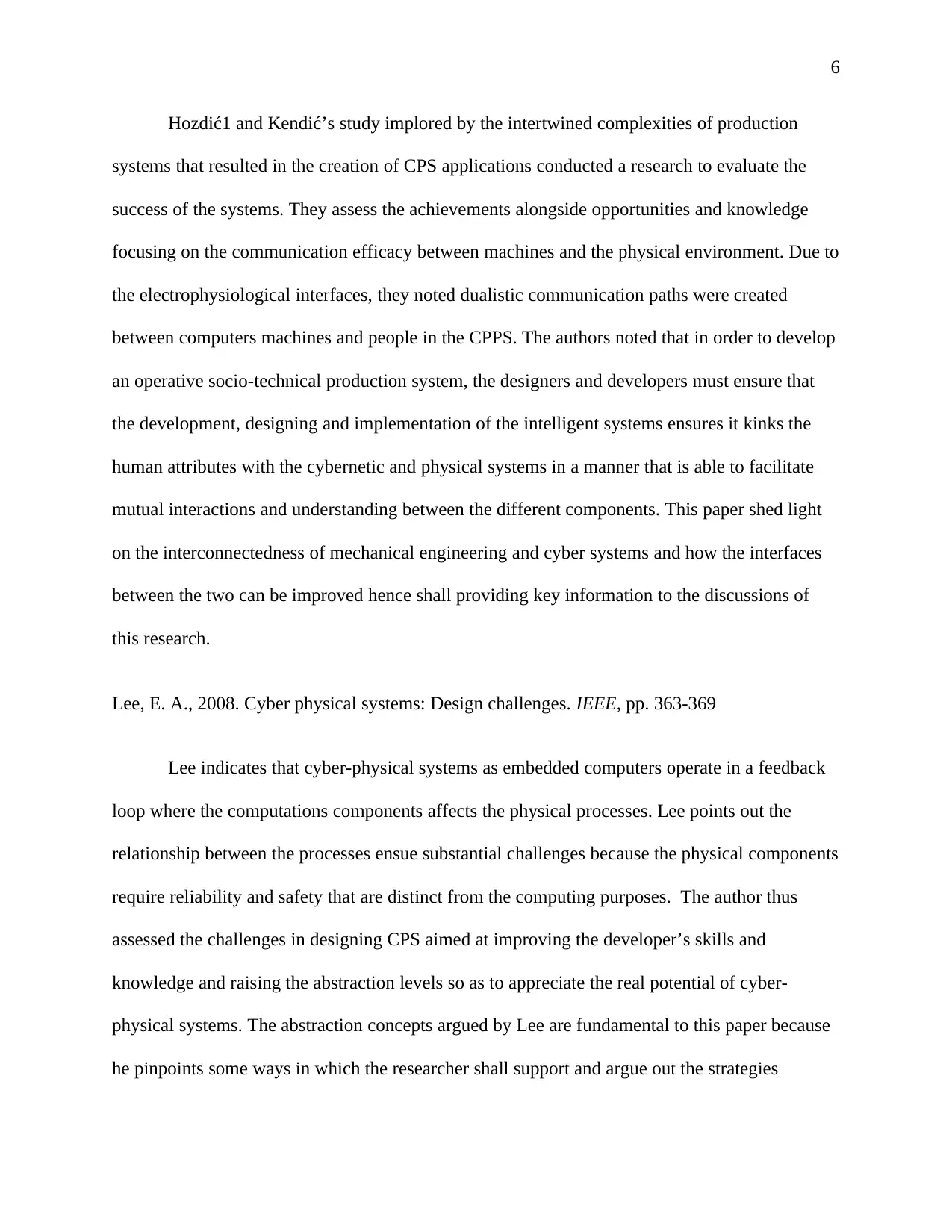
6
Hozdić1 and Kendić’s study implored by the intertwined complexities of production
systems that resulted in the creation of CPS applications conducted a research to evaluate the
success of the systems. They assess the achievements alongside opportunities and knowledge
focusing on the communication efficacy between machines and the physical environment. Due to
the electrophysiological interfaces, they noted dualistic communication paths were created
between computers machines and people in the CPPS. The authors noted that in order to develop
an operative socio-technical production system, the designers and developers must ensure that
the development, designing and implementation of the intelligent systems ensures it kinks the
human attributes with the cybernetic and physical systems in a manner that is able to facilitate
mutual interactions and understanding between the different components. This paper shed light
on the interconnectedness of mechanical engineering and cyber systems and how the interfaces
between the two can be improved hence shall providing key information to the discussions of
this research.
Lee, E. A., 2008. Cyber physical systems: Design challenges. IEEE, pp. 363-369
Lee indicates that cyber-physical systems as embedded computers operate in a feedback
loop where the computations components affects the physical processes. Lee points out the
relationship between the processes ensue substantial challenges because the physical components
require reliability and safety that are distinct from the computing purposes. The author thus
assessed the challenges in designing CPS aimed at improving the developer’s skills and
knowledge and raising the abstraction levels so as to appreciate the real potential of cyber-
physical systems. The abstraction concepts argued by Lee are fundamental to this paper because
he pinpoints some ways in which the researcher shall support and argue out the strategies
Hozdić1 and Kendić’s study implored by the intertwined complexities of production
systems that resulted in the creation of CPS applications conducted a research to evaluate the
success of the systems. They assess the achievements alongside opportunities and knowledge
focusing on the communication efficacy between machines and the physical environment. Due to
the electrophysiological interfaces, they noted dualistic communication paths were created
between computers machines and people in the CPPS. The authors noted that in order to develop
an operative socio-technical production system, the designers and developers must ensure that
the development, designing and implementation of the intelligent systems ensures it kinks the
human attributes with the cybernetic and physical systems in a manner that is able to facilitate
mutual interactions and understanding between the different components. This paper shed light
on the interconnectedness of mechanical engineering and cyber systems and how the interfaces
between the two can be improved hence shall providing key information to the discussions of
this research.
Lee, E. A., 2008. Cyber physical systems: Design challenges. IEEE, pp. 363-369
Lee indicates that cyber-physical systems as embedded computers operate in a feedback
loop where the computations components affects the physical processes. Lee points out the
relationship between the processes ensue substantial challenges because the physical components
require reliability and safety that are distinct from the computing purposes. The author thus
assessed the challenges in designing CPS aimed at improving the developer’s skills and
knowledge and raising the abstraction levels so as to appreciate the real potential of cyber-
physical systems. The abstraction concepts argued by Lee are fundamental to this paper because
he pinpoints some ways in which the researcher shall support and argue out the strategies
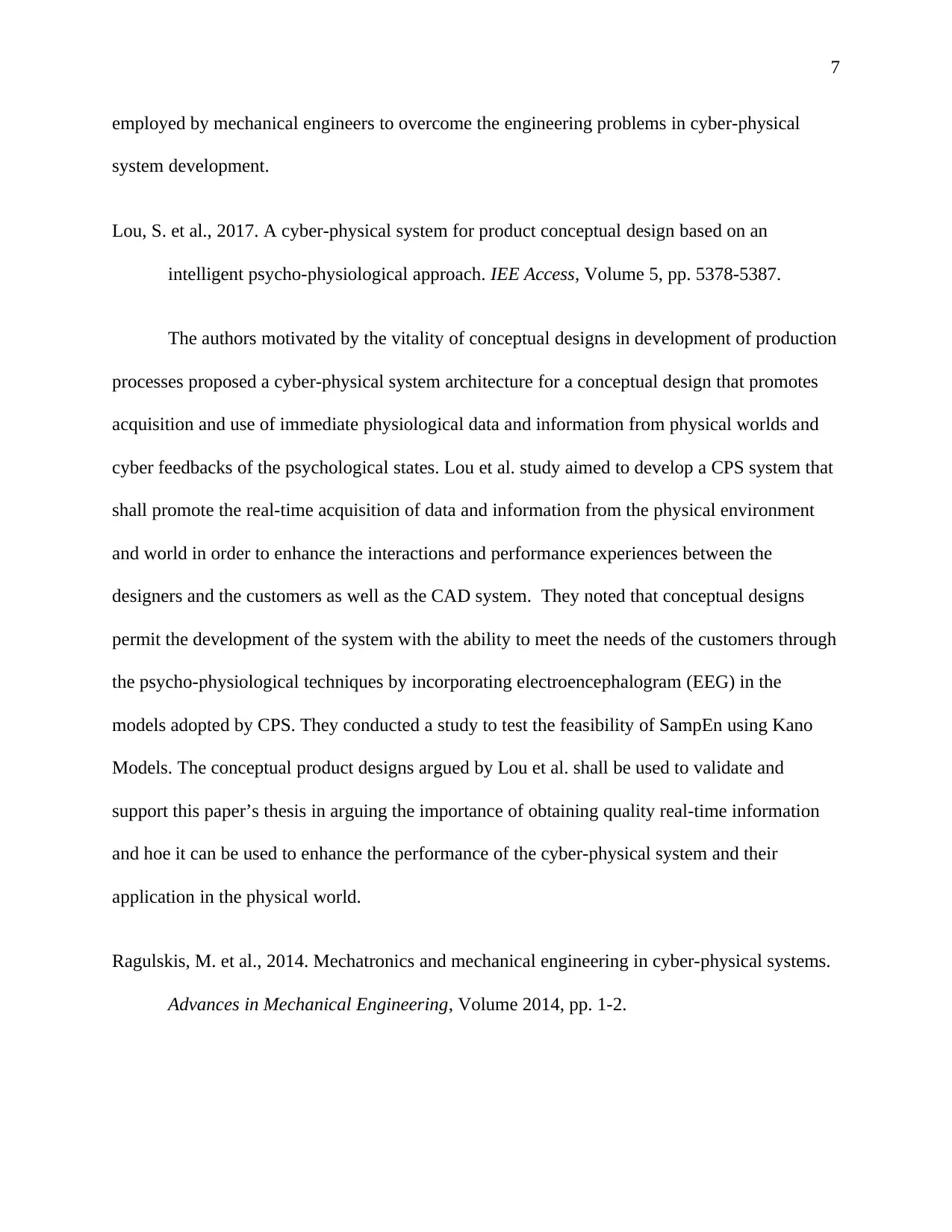
7
employed by mechanical engineers to overcome the engineering problems in cyber-physical
system development.
Lou, S. et al., 2017. A cyber-physical system for product conceptual design based on an
intelligent psycho-physiological approach. IEE Access, Volume 5, pp. 5378-5387.
The authors motivated by the vitality of conceptual designs in development of production
processes proposed a cyber-physical system architecture for a conceptual design that promotes
acquisition and use of immediate physiological data and information from physical worlds and
cyber feedbacks of the psychological states. Lou et al. study aimed to develop a CPS system that
shall promote the real-time acquisition of data and information from the physical environment
and world in order to enhance the interactions and performance experiences between the
designers and the customers as well as the CAD system. They noted that conceptual designs
permit the development of the system with the ability to meet the needs of the customers through
the psycho-physiological techniques by incorporating electroencephalogram (EEG) in the
models adopted by CPS. They conducted a study to test the feasibility of SampEn using Kano
Models. The conceptual product designs argued by Lou et al. shall be used to validate and
support this paper’s thesis in arguing the importance of obtaining quality real-time information
and hoe it can be used to enhance the performance of the cyber-physical system and their
application in the physical world.
Ragulskis, M. et al., 2014. Mechatronics and mechanical engineering in cyber-physical systems.
Advances in Mechanical Engineering, Volume 2014, pp. 1-2.
employed by mechanical engineers to overcome the engineering problems in cyber-physical
system development.
Lou, S. et al., 2017. A cyber-physical system for product conceptual design based on an
intelligent psycho-physiological approach. IEE Access, Volume 5, pp. 5378-5387.
The authors motivated by the vitality of conceptual designs in development of production
processes proposed a cyber-physical system architecture for a conceptual design that promotes
acquisition and use of immediate physiological data and information from physical worlds and
cyber feedbacks of the psychological states. Lou et al. study aimed to develop a CPS system that
shall promote the real-time acquisition of data and information from the physical environment
and world in order to enhance the interactions and performance experiences between the
designers and the customers as well as the CAD system. They noted that conceptual designs
permit the development of the system with the ability to meet the needs of the customers through
the psycho-physiological techniques by incorporating electroencephalogram (EEG) in the
models adopted by CPS. They conducted a study to test the feasibility of SampEn using Kano
Models. The conceptual product designs argued by Lou et al. shall be used to validate and
support this paper’s thesis in arguing the importance of obtaining quality real-time information
and hoe it can be used to enhance the performance of the cyber-physical system and their
application in the physical world.
Ragulskis, M. et al., 2014. Mechatronics and mechanical engineering in cyber-physical systems.
Advances in Mechanical Engineering, Volume 2014, pp. 1-2.
Paraphrase This Document
Need a fresh take? Get an instant paraphrase of this document with our AI Paraphraser
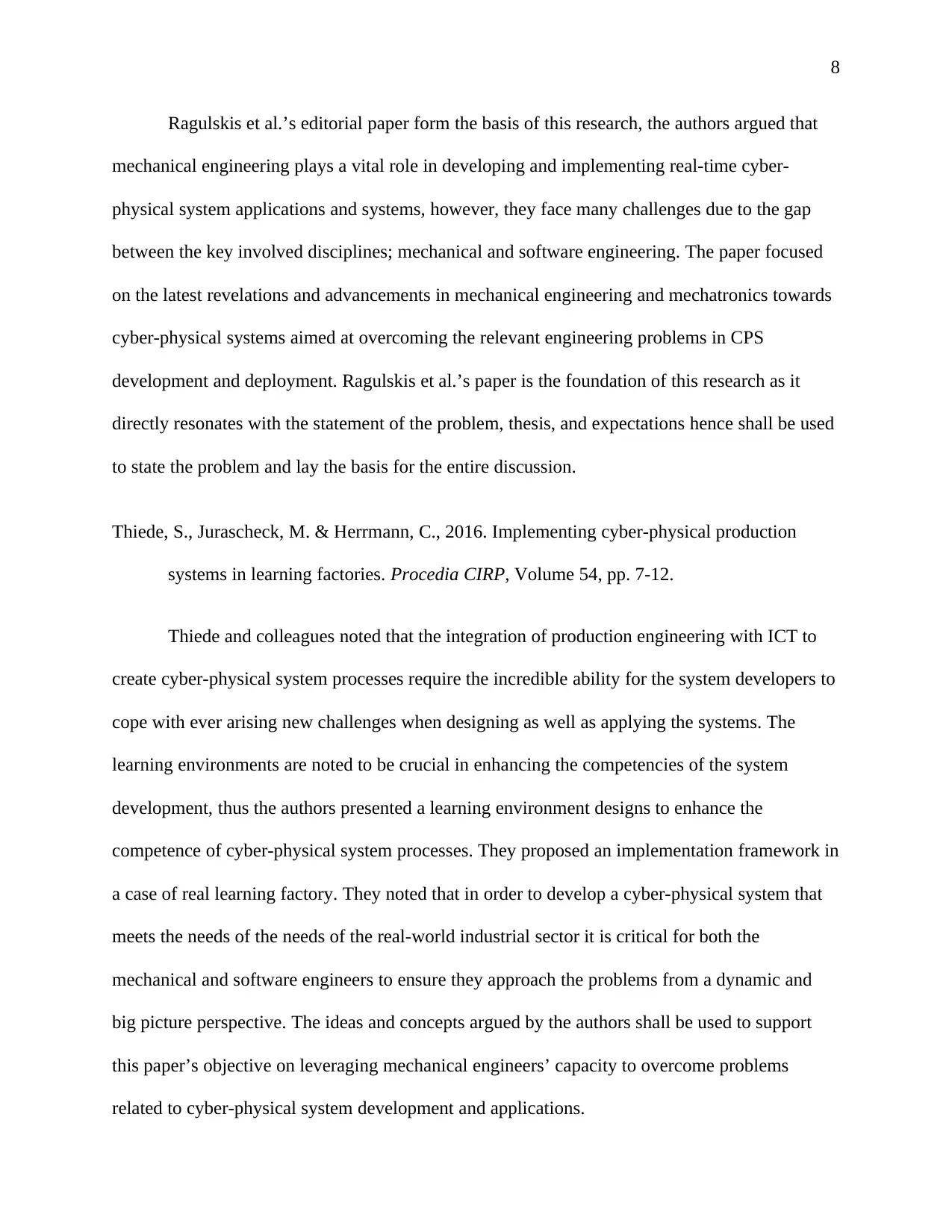
8
Ragulskis et al.’s editorial paper form the basis of this research, the authors argued that
mechanical engineering plays a vital role in developing and implementing real-time cyber-
physical system applications and systems, however, they face many challenges due to the gap
between the key involved disciplines; mechanical and software engineering. The paper focused
on the latest revelations and advancements in mechanical engineering and mechatronics towards
cyber-physical systems aimed at overcoming the relevant engineering problems in CPS
development and deployment. Ragulskis et al.’s paper is the foundation of this research as it
directly resonates with the statement of the problem, thesis, and expectations hence shall be used
to state the problem and lay the basis for the entire discussion.
Thiede, S., Jurascheck, M. & Herrmann, C., 2016. Implementing cyber-physical production
systems in learning factories. Procedia CIRP, Volume 54, pp. 7-12.
Thiede and colleagues noted that the integration of production engineering with ICT to
create cyber-physical system processes require the incredible ability for the system developers to
cope with ever arising new challenges when designing as well as applying the systems. The
learning environments are noted to be crucial in enhancing the competencies of the system
development, thus the authors presented a learning environment designs to enhance the
competence of cyber-physical system processes. They proposed an implementation framework in
a case of real learning factory. They noted that in order to develop a cyber-physical system that
meets the needs of the needs of the real-world industrial sector it is critical for both the
mechanical and software engineers to ensure they approach the problems from a dynamic and
big picture perspective. The ideas and concepts argued by the authors shall be used to support
this paper’s objective on leveraging mechanical engineers’ capacity to overcome problems
related to cyber-physical system development and applications.
Ragulskis et al.’s editorial paper form the basis of this research, the authors argued that
mechanical engineering plays a vital role in developing and implementing real-time cyber-
physical system applications and systems, however, they face many challenges due to the gap
between the key involved disciplines; mechanical and software engineering. The paper focused
on the latest revelations and advancements in mechanical engineering and mechatronics towards
cyber-physical systems aimed at overcoming the relevant engineering problems in CPS
development and deployment. Ragulskis et al.’s paper is the foundation of this research as it
directly resonates with the statement of the problem, thesis, and expectations hence shall be used
to state the problem and lay the basis for the entire discussion.
Thiede, S., Jurascheck, M. & Herrmann, C., 2016. Implementing cyber-physical production
systems in learning factories. Procedia CIRP, Volume 54, pp. 7-12.
Thiede and colleagues noted that the integration of production engineering with ICT to
create cyber-physical system processes require the incredible ability for the system developers to
cope with ever arising new challenges when designing as well as applying the systems. The
learning environments are noted to be crucial in enhancing the competencies of the system
development, thus the authors presented a learning environment designs to enhance the
competence of cyber-physical system processes. They proposed an implementation framework in
a case of real learning factory. They noted that in order to develop a cyber-physical system that
meets the needs of the needs of the real-world industrial sector it is critical for both the
mechanical and software engineers to ensure they approach the problems from a dynamic and
big picture perspective. The ideas and concepts argued by the authors shall be used to support
this paper’s objective on leveraging mechanical engineers’ capacity to overcome problems
related to cyber-physical system development and applications.
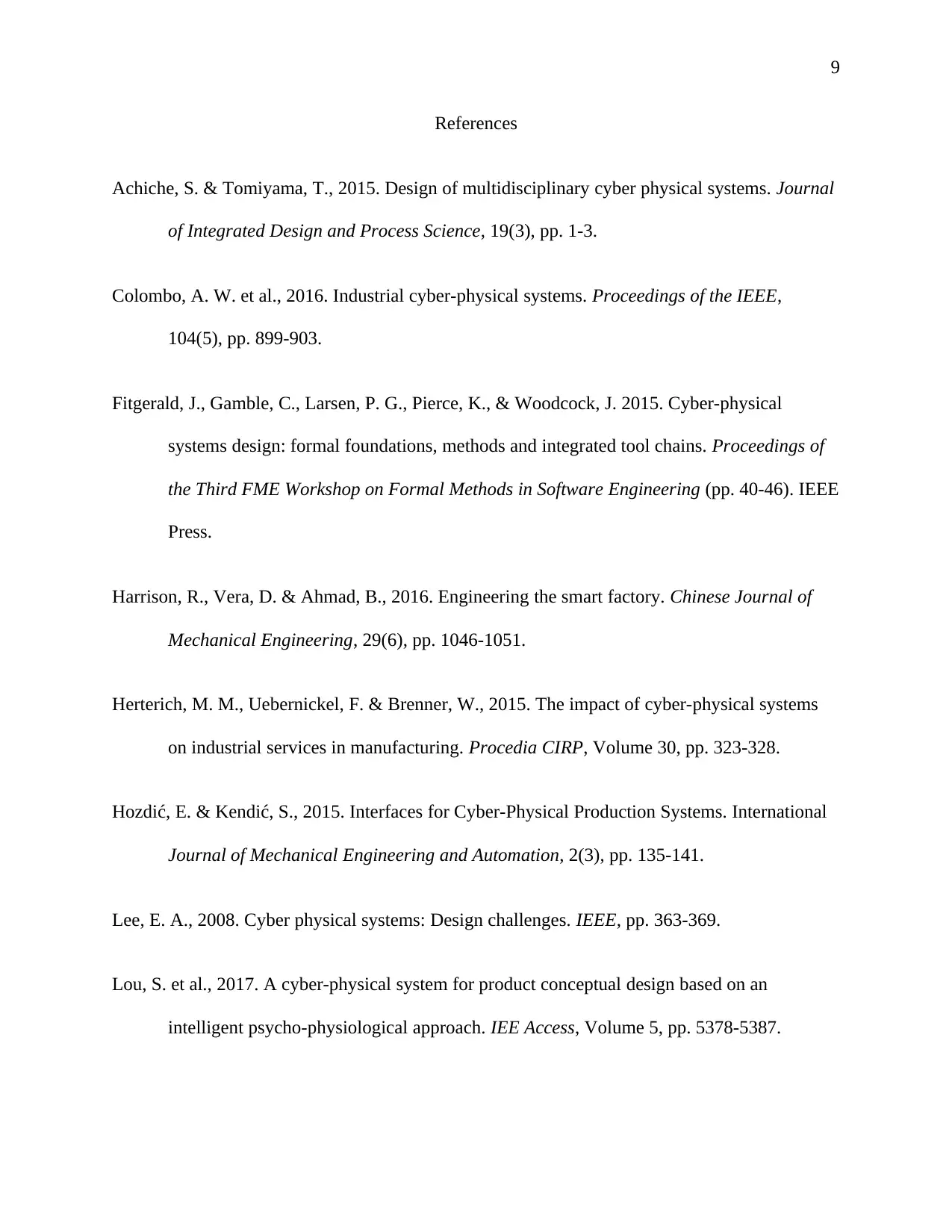
9
References
Achiche, S. & Tomiyama, T., 2015. Design of multidisciplinary cyber physical systems. Journal
of Integrated Design and Process Science, 19(3), pp. 1-3.
Colombo, A. W. et al., 2016. Industrial cyber-physical systems. Proceedings of the IEEE,
104(5), pp. 899-903.
Fitgerald, J., Gamble, C., Larsen, P. G., Pierce, K., & Woodcock, J. 2015. Cyber-physical
systems design: formal foundations, methods and integrated tool chains. Proceedings of
the Third FME Workshop on Formal Methods in Software Engineering (pp. 40-46). IEEE
Press.
Harrison, R., Vera, D. & Ahmad, B., 2016. Engineering the smart factory. Chinese Journal of
Mechanical Engineering, 29(6), pp. 1046-1051.
Herterich, M. M., Uebernickel, F. & Brenner, W., 2015. The impact of cyber-physical systems
on industrial services in manufacturing. Procedia CIRP, Volume 30, pp. 323-328.
Hozdić, E. & Kendić, S., 2015. Interfaces for Cyber-Physical Production Systems. International
Journal of Mechanical Engineering and Automation, 2(3), pp. 135-141.
Lee, E. A., 2008. Cyber physical systems: Design challenges. IEEE, pp. 363-369.
Lou, S. et al., 2017. A cyber-physical system for product conceptual design based on an
intelligent psycho-physiological approach. IEE Access, Volume 5, pp. 5378-5387.
References
Achiche, S. & Tomiyama, T., 2015. Design of multidisciplinary cyber physical systems. Journal
of Integrated Design and Process Science, 19(3), pp. 1-3.
Colombo, A. W. et al., 2016. Industrial cyber-physical systems. Proceedings of the IEEE,
104(5), pp. 899-903.
Fitgerald, J., Gamble, C., Larsen, P. G., Pierce, K., & Woodcock, J. 2015. Cyber-physical
systems design: formal foundations, methods and integrated tool chains. Proceedings of
the Third FME Workshop on Formal Methods in Software Engineering (pp. 40-46). IEEE
Press.
Harrison, R., Vera, D. & Ahmad, B., 2016. Engineering the smart factory. Chinese Journal of
Mechanical Engineering, 29(6), pp. 1046-1051.
Herterich, M. M., Uebernickel, F. & Brenner, W., 2015. The impact of cyber-physical systems
on industrial services in manufacturing. Procedia CIRP, Volume 30, pp. 323-328.
Hozdić, E. & Kendić, S., 2015. Interfaces for Cyber-Physical Production Systems. International
Journal of Mechanical Engineering and Automation, 2(3), pp. 135-141.
Lee, E. A., 2008. Cyber physical systems: Design challenges. IEEE, pp. 363-369.
Lou, S. et al., 2017. A cyber-physical system for product conceptual design based on an
intelligent psycho-physiological approach. IEE Access, Volume 5, pp. 5378-5387.

10
Ragulskis, M. et al., 2014. Mechatronics and mechanical engineering in cyber-physical systems.
Advances in Mechanical Engineering, Volume 2014, pp. 1-2.
Thiede, S., Jurascheck, M. & Herrmann, C., 2016. Implementing cyber-physical production
systems in learning factories. Procedia CIRP, Volume 54, pp. 7-12.
Ragulskis, M. et al., 2014. Mechatronics and mechanical engineering in cyber-physical systems.
Advances in Mechanical Engineering, Volume 2014, pp. 1-2.
Thiede, S., Jurascheck, M. & Herrmann, C., 2016. Implementing cyber-physical production
systems in learning factories. Procedia CIRP, Volume 54, pp. 7-12.
1 out of 10
Related Documents
Your All-in-One AI-Powered Toolkit for Academic Success.
+13062052269
info@desklib.com
Available 24*7 on WhatsApp / Email
![[object Object]](/_next/static/media/star-bottom.7253800d.svg)
Unlock your academic potential
© 2024 | Zucol Services PVT LTD | All rights reserved.





